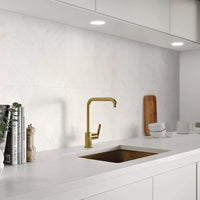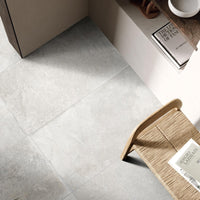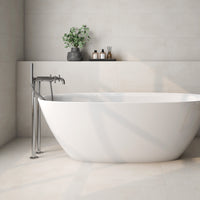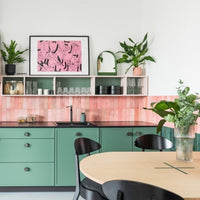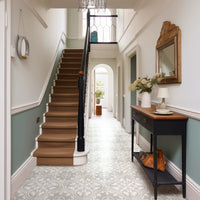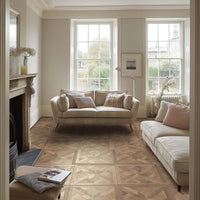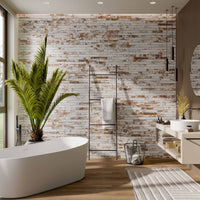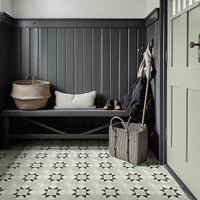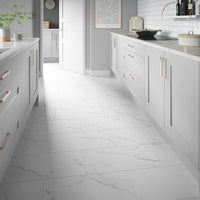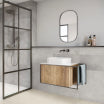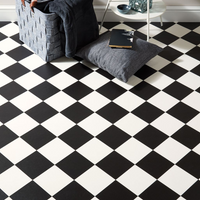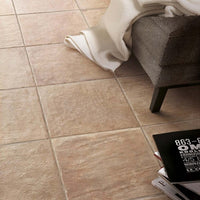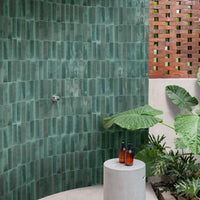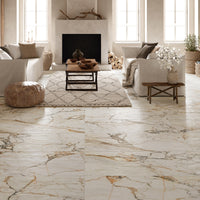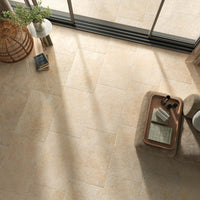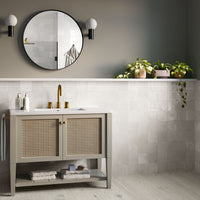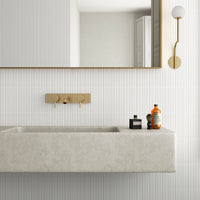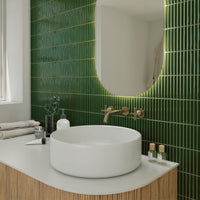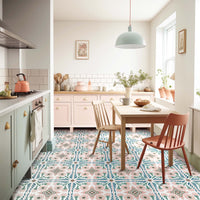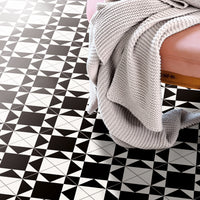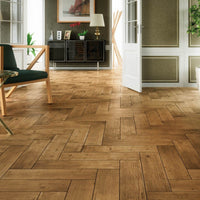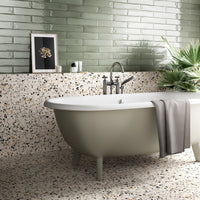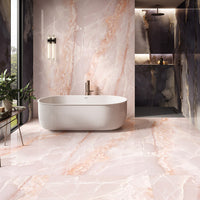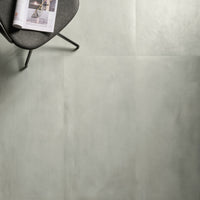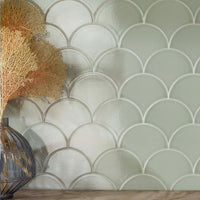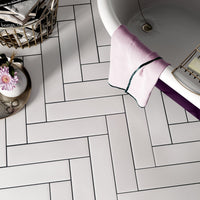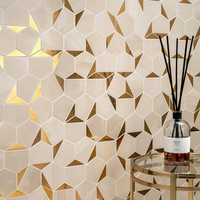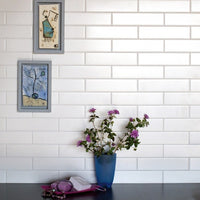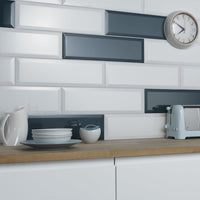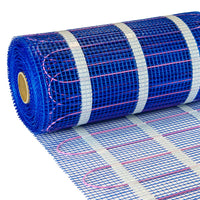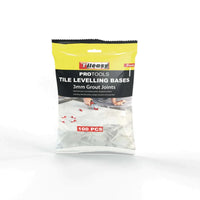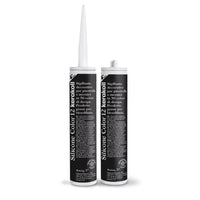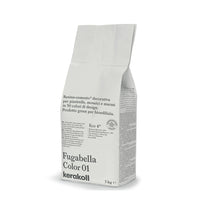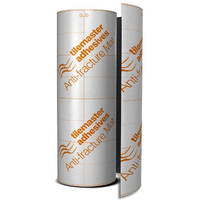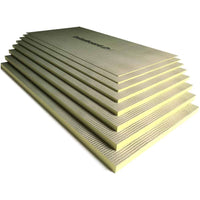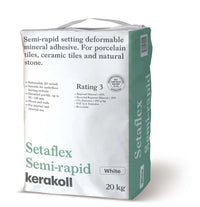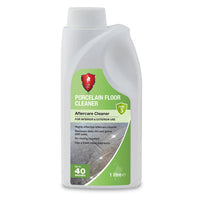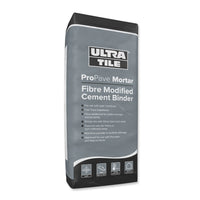If you’re thinking of re-doing your bathroom, there’s a pretty good chance you’ll have thought about wood effect tiles. They’re a natural fit for wet areas as not only do they look great, they’re also unaffected by moisture or condensation and won’t swell when wet - an important consideration for a room that’s often steamy.
And by their nature, they exude calm and tranquility. Exactly what’s required to help create a serene and relaxing space at home, in other words. In this article, we’ll explore some creative ways you can use wood tiles, to help create an inspiring bathroom project.
Modern Moroccan

We’re stating the obvious, but wood tiles don’t just come in shades of warming oak. Some of the more popular timber tones in the last few years have been grey, as you might expect. And while grey tiles are often used to create sleek, modern interiors, they can also be laid in more muted schemes.
For example, in this beautiful bathroom, shades of off-white and grey have been combined to create a space with one foot in the present, and one in the past. On the floor, grey wood tiles with a rustic finish compliment the artisanal finish of the Zellige Pearl tiles on the walls, the top of which are finished in Margot by Coat Paints. The subtle contrast between the different materials helps tie everything together, giving the space an authentic and cosy feel.
Trendy Loft Apartment

Not all rooms are neat and square, especially in older properties. A great way to achieve a unique finish is to embrace your home’s idiosyncrasies and quirks, rather than work against them. This attic bathroom - in a converted warehouse apartment - is a great case in point.
With a sloped ceiling and lack of natural light, it’s a tricky room to get right. And rather than opt for the usual ‘pale and polished’ materials to make the space feel bigger, the designers have opted for dark, matt surfaces on the whole. The royal blue basin cabinet, walnut-coloured floor tiles and distressed subway tiles don’t just offer visual interest, they also help to make the room feel cosy and inviting. The rustic texture of the wood tiles provides a great contrast to the sleek finish of the freestanding bath and industrial brassware, giving the scheme a look that’s industrial, modern and certainly one-of-a-kind.
Groovy Edges

Slat wood panels? They’re everywhere these days. Well, everywhere that is, apart from shower walls and bathrooms. Most of the panels are made form veneers which aren’t well suited to wet and demanding areas. Or to put it another way, they’ll warp, peel and deteriorate rather quickly.
On the other hand, slatted timber-look tiles are made from ceramic and porcelain. A little water - or a deluge - won’t bother them. This opens up a whole new world of design possibilities that, quite frankly, didn’t exists just a few years ago. And although they’re relatively new to the market, we’re expecting them to become a hot trend. They’re a great way to create a feature wall in a neutral bathroom, adding statement texture to showering spaces and splashbacks.
On A Plinth

It’s easy to see why freestanding baths have become such a huge trend in recent years. After all, who doesn’t love a long, hot soak - especially in a stone tub that’s the epitome of five-star luxury? However, these kind of baths can sometimes present a challenge when it comes to plumbing. All that water has to drain into a waste pipe somewhere and more often than not, there’s a floor joist or two in the way.
A great way to overcome this issue is to raise the floor directly underneath the bath, giving your plumber more space to pass his pipes and putting your soak on a pedestal, so to speak. It’s a practical solution to a functional problem, and can be used to elegant effect, as shown in this spa-like bathroom which is almost entirely covered in our Symphony Marble tiles. The space is only broken up by the oak-effect tiles under the bath, which add contrasting warmth to the scheme, helping the bath to become a focal point instead of fading into the background tiling.
Warm Glam

When it comes to elevating a space, a favourite trick of interior designers is to pair different materials together. In the previous example, we saw how wood tiles were contrasted against white marble to help define the bathing area - and you can use the same trick throughout your bathroom, to great effect.
In this space, the entire floor is covered in oak-effect planks, which help to warm up the room. Sometimes, all-over white marble can feel a little too cold and clinical. And although the room has no natural light, it still feels spacious and inviting; the knots and veins present in the floor and wall tiles compliment each other perfectly so the whole space feels balanced.
You can achieve a similar look in your own home with our Timber Oak and Divine Gold tiles. Finish the scheme off with timber shelves and well-chosen accessories; this looks is all about warm minimalism.
Luxury With A Twist

A huge advantage that porcelain tiles enjoy over other materials is how versatile they are - you can usually lay the same tile in a variety of places, from your hallway floor to your kitchen wall.
And a great way to give your home an unexpected twist is to lay wood tiles onto your walls. But not just any wood tile; to get the full effect, we’d recommend fixing super-size parquet slabs to your shower walls, as shown in this luxurious wetroom. It’s unconventional but works - especially if you love the idea of turning things on their head. To really nail the impact, go as decadent as possible with Mansion Parquet - the intricate inlaid details will transform your morning shower into a glamorous ritual.
Understated Style

Much as we love a glamorous hotel-style space, we also love a bathroom on the understated side. After all, it’s a room that’s designed as much for rest and relaxation, as it is a place to quickly spruce up in the morning.
That’s where wood tiles - and chevron-shaped wood tiles in particular - come in. Tiles like our Avalon Oak will elevate your floor beyond the ordinary, without making it demand too much attention. Combined with other natural materials such as marble and stone, they can be used to create an interior with a handsome, relaxed vibe. The type of space you’ll naturally want to linger in and switch off…
And while the room above is on the larger side with plenty of natural light, it goes without saying that many of us have bathrooms on the smaller side. However, chevron tiles will still work wonders in smaller spaces - they’ll add that much-coveted character and detail, without overwhelming the room.
All-over Warmth

Bathrooms can be tricky to get right. On the one hand, we want them to be functional spaces; full of clean lines and sharp edges. And on the other hand, we need them to fulfil our desire for warmth and serenity.
It’s a balancing act for sure, but one made much easier with wood tiles. Pick the right design - in our eyes, that’s one with some gentle grains, warm colouring and a couple of knots, here and there - and you’re halfway to creating a bathroom that’s sleek but full of much-needed character. Keep the rest of the design scheme muted with pale beige wall tiles, rose-gold brassware and designer furniture and you’ll have a space that doesn’t just look great but stirs the soul as well.
Floor To Wall

When it comes to tiling bathrooms, we’re often asked by customers which wall tiles we’d recommend when you’re using wood tiles on the floor. Luckily, many designs pair well - the warm, organic tones you’d expect to find in timber tiles work extremely well with natural and neutral wall tile options.
However, we’re slowly seeing the emergence of a completely new - and exciting - design trend, where the same wood tiles continue from the floor and up onto the walls. This works really well with planks that are 120cm long, as it’s a natural height for a part-tiled wall. It’s a modern take on the classic ‘tongue-and-groove’ panelling you often find in older properties and is wipe-clean and waterproof to boot. We’d recommend pairing the top half of your walls in a paler colour, to contrast against the tiles and let them take centre stage.
